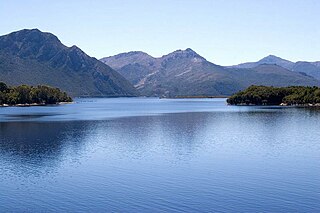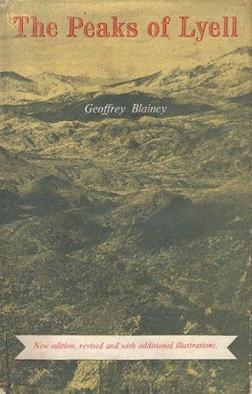Related Research Articles

The Lyell Highway is a highway in Tasmania, running from Hobart to Queenstown. It is the one of two transport routes that passes through the West Coast Range, the other being the B28 Anthony Road.

The West Coast of Tasmania is mainly isolated rough country, associated with wilderness, mining and tourism. It served as the location of an early convict settlement in the early history of Van Diemen's Land, and contrasts sharply with the more developed and populous northern and eastern parts of the island state.
Mount Lyell Mining and Railway Company was a Tasmanian mining company formed on 29 March 1893, most commonly referred to as Mount Lyell. Mount Lyell was the dominant copper mining company of the West Coast from 1893 to 1994, and was based in Queenstown, Tasmania.
The North Mount Lyell disaster refers to a fire that broke out on 12 October 1912 at the Mount Lyell Mining and Railway Company operations on the West Coast of Tasmania, killing 42 miners. The mine had been taken over from the North Mount Lyell Company in 1903.
Crotty is the site of a former gazetted town in Western Tasmania, Australia. The town was on the southern bank of the King River, on the eastern lower slopes of Mount Jukes, below the West Coast Range. The locality was formerly named King River

The North Mount Lyell Railway was built to operate between the North Mount Lyell mine in West Coast Tasmania and Pillinger in the Kelly Basin of Macquarie Harbour.

Mount Owen is a mountain directly east of the town of Queenstown on the West Coast Range in Western Tasmania, Australia.
The Mount Jukes mine sites were a series of short-lived, small mine workings high on the upper regions of Mount Jukes in the West Coast Range on the West Coast of Tasmania.
North Mount Lyell was the name of a mine, mining company, locality and former railway north of Gormanston on the southern slopes of Mount Lyell in the West Coast Range on the West Coast of Tasmania, and on to the ridge between Mount Lyell and Mount Owen.

The Peaks of Lyell is a book by Geoffrey Blainey, based on his University of Melbourne MA thesis originally published in 1954. It contains the history of the Mount Lyell Mining and Railway Company, and through association, Queenstown and further the West Coast Tasmania.

Kelly Basin is a bay on the south eastern side of Macquarie Harbour on the West Coast of Tasmania. It was named after James Kelly an early explorer of the Tasmanian coastline. It was the location of the terminus of the North Mount Lyell Railway and the town of Pillinger.
The mines of the West Coast of Tasmania have a rich historical heritage as well as an important mineralogical value in containing or having had found, specimens of rare and unusual minerals. Also, the various mining fields have important roles in the understanding of the mineralization of the Mount Read Volcanics, and the occurrence of economic minerals.
The history of the Railways on the West Coast of Tasmania has fascinated enthusiasts from around the world, because of the combination of the harsh terrain in which the railways were created, and the unique nature of most of the lines.
The Strahan–Zeehan Railway, also known as the "Government Railway", was a railway from Strahan to Zeehan on the west coast of Tasmania.
Thomas Bather Moore was a pioneer explorer of Western and South West, Tasmania, Australia.

Linda is the site of an old ghost town in the Linda Valley in the West Coast Range of Tasmania, Australia. It has also been known as Linda Valley.
The Sticht Range is a mountain range located in the West Coast region of Tasmania, Australia. The range runs between two tributaries of the Eldon River and is located within the eastern part of the West Coast Range and has an unnamed peak with an elevation of 1,080 metres (3,540 ft) above sea level.
Charles Whitham was the author of the oft-reprinted Western Tasmania: A land of Riches and Beauty, which was a comprehensive study of the geographical features of West Coast, Tasmania and the conditions of the region in the 1920s.
James Crotty was an Irish-born Australian mining prospector who formed a mining company, the North Mount Lyell mining company, in the western region of Tasmania, just before the turn of the twentieth century.

Iron Blow was the site of the earliest major mining venture at Mount Lyell on the west coast of Tasmania, Australia in 1883.
References
- 1 2 Blainey, Geoffrey (2000). The Peaks of Lyell (6th ed.). Hobart: St. David's Park Publishing. ISBN 0-7246-2265-9.
- ↑ For a full appreciation of the players and the details of the "wars" - Geoffrey Blainey's The Peaks of Lyell - chapter 13 "The Railway War" pp112-133 and Glyn Roberts Metal Mining...Roberts, Glyn; Roberts, Glyn (2007), Metal mining in Tasmania, 1804 to 1914 : how government helped shape the mining industry (1st ed.), Bokprint Pty. Ltd. in conjunction with Fullers Bookshop, ISBN 978-0-9585174-1-6 - chapter 19 pp 363-380 "Access to the West Coast" give different and useful approaches to the events
- ↑ "Great Western Railway, Tasmania". The Sydney Morning Herald . No. 19, 061. New South Wales, Australia. 17 April 1899. p. 5. Retrieved 18 January 2024– via National Library of Australia.
- ↑ "The Great Western Railway (Tasmania)". The Daily Telegraph . No. 6634. New South Wales, Australia. 14 September 1900. p. 5. Retrieved 18 January 2024– via National Library of Australia.
- ↑ "Great Western Railway. Tasmania". Kalgoorlie Miner . Vol. 8, no. 18668. Western Australia. 17 January 1903. p. 5. Retrieved 18 January 2024– via National Library of Australia.
- ↑ Geoffrey Blainey's "Population Movements in Tasmania, 1870-1901", in Tasmanian Historical Research Association, Papers and Proceedings, vol.3, 1954, pp.62-70. "The Rise and Decline of the West Coast", in Tasmanian Historical Research Association. Papers and Proceedings, vol.4, 1955, pp.66-74. both articles give an early view on the Tasmanian regional rivalries and the resolution through the downfall of the west Coast influence